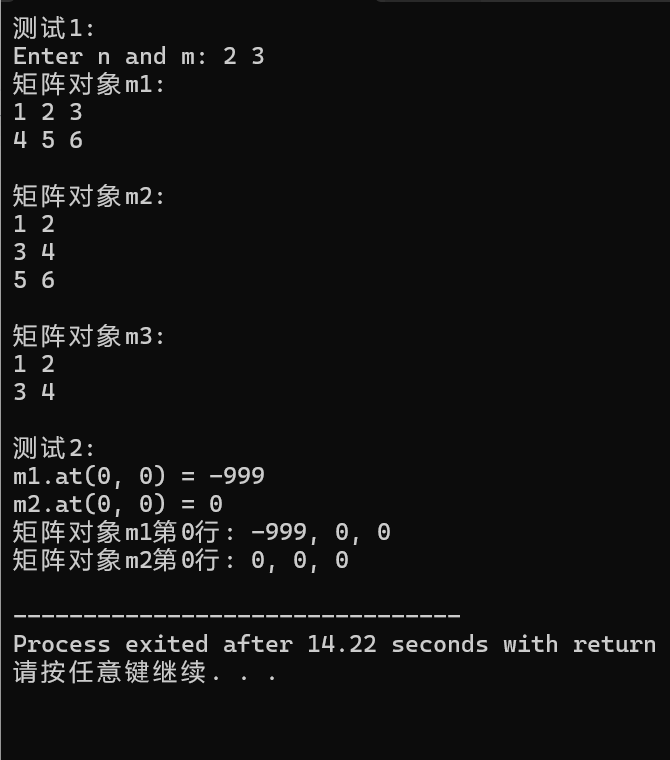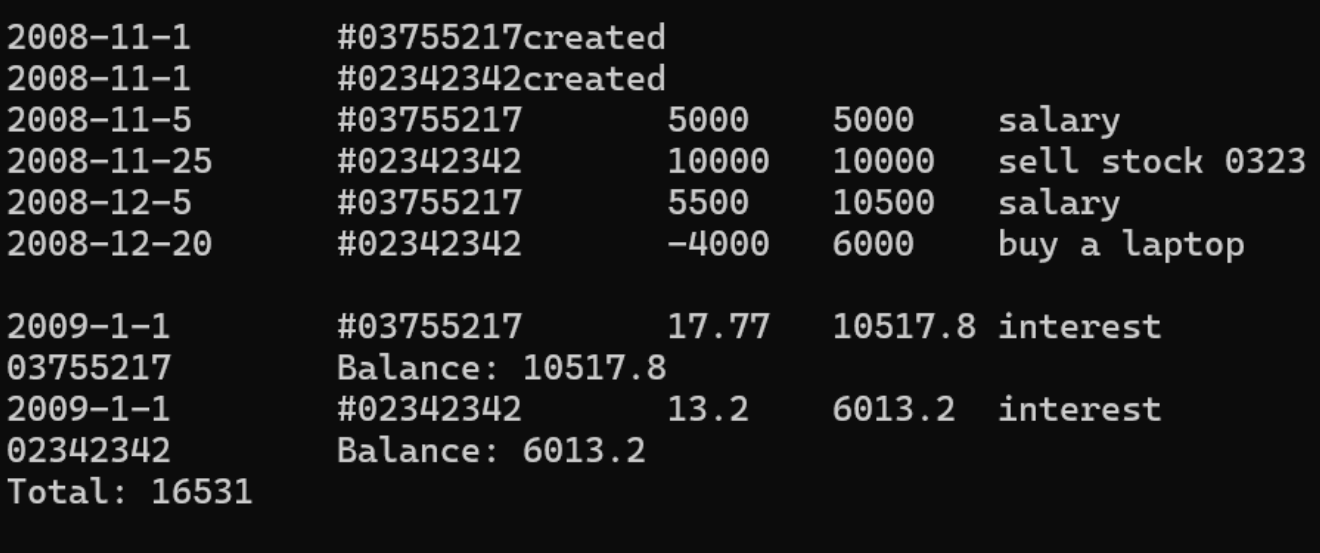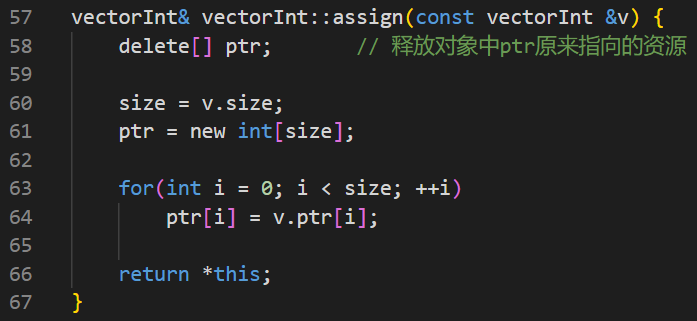实验3 类和对象_基础编程2
一、实验目的
- 加深对类的组合机制(has-a)的理解,会使用C++正确定义、使用组合类
- 理解深复制、浅复制
- 练习标准库string, vector用法,能基于问题场景灵活使用
- 针对具体问题场景,练习运用面向对象思维进行设计,合理设计、组合类(自定义/标准库),编程解决实际问题
二、实验内容
1. 实验任务1
验证性实验:组合类的定义和使用。
组合类用于抽象现实世界has-a关系。这个简单示例模拟了GUI的窗口和部件。覆盖了以下内容:
- 组合类的定义、使用(注意组合类构造函数的写法)
- 数据的共享、保护:const引用作为形参
- 标准库vector, string
- 以多文件方式组织代码
button.hpp Button类的定义
window.hpp Window类的定义
task1.cpp 测试代码、main()
button.hpp
#pragma once #include <iostream> #include <string> using std::string; using std::cout; // 按钮类 class Button { public: Button(const string &text); string get_label() const; void click(); private: string label; }; Button::Button(const string &text): label{text} { } inline string Button::get_label() const { return label; } void Button::click() { cout << "Button '" << label << "' clicked\n"; }
window.hpp
#pragma once #include "button.hpp" #include <vector> #include <iostream> using std::vector; using std::cout; using std::endl; // 窗口类 class Window{ public: Window(const string &win_title); void display() const; void close(); void add_button(const string &label); private: string title; vector<Button> buttons; }; Window::Window(const string &win_title): title{win_title} { buttons.push_back(Button("close")); } inline void Window::display() const { string s(40, '*'); cout << s << endl; cout << "window title: " << title << endl; cout << "It has " << buttons.size() << " buttons: " << endl; for(const auto &i: buttons) cout << i.get_label() << " button" << endl; cout << s << endl; } void Window::close() { cout << "close window '" << title << "'" << endl; buttons.at(0).click(); } void Window::add_button(const string &label) { buttons.push_back(Button(label)); }
task1.cpp
#include "window.hpp" #include <iostream> using std::cout; using std::cin; void test() { Window w1("new window"); w1.add_button("maximize"); w1.display(); w1.close(); } int main() { cout << "用组合类模拟简单GUI:\n"; test(); }
运行截图:

问题1:这个模拟简单GUI的示例代码中,自定义了几个类?使用到了标准库的哪几个类?,哪些
类和类之间存在组合关系?
问题2:在自定义类Button和Window中,有些成员函数定义时加了const, 有些设置成了inline。如
果你是类的设计者,目前那些没有加const或没有设置成inline的,适合添加const,适合设置成
inline吗?陈述你的答案和理由。
问题3:类Window的定义中,有这样一行代码,其功能是?
1.答:自定义两个类:分别是button类和window类;
使用标准库类:iostream类、string类和vector类;
组合关系:Window 类中包含了 vector<Button>,表示窗口中包含多个按钮,这是一种组合关系。
Window 类的构造函数中创建了一个 Button对象,用于将给定的短语添加到类中定义的向量中。
2.答:不适合,其余的成员函数中都包含了会变化的量,涉及到内部状态的修改,如果设置成const或者inline,则有可能报错。
3.答:其功能是定义一个字符串变量s,给它赋40个‘*’,用来作为GUI的模拟界面窗口。
2. 实验任务2
task2.cpp
#include <iostream> #include <vector> using namespace std; void output1(const vector<int> &v) { for(auto &i: v) cout << i << ", "; cout << "\b\b \n"; } void output2(const vector<vector<int>> v) { for(auto &i: v) { for(auto &j: i) cout << j << ", "; cout << "\b\b \n"; } } void test1() { vector<int> v1(5, 42); const vector<int> v2(v1); v1.at(0) = -999; cout << "v1: "; output1(v1); cout << "v2: "; output1(v2); cout << "v1.at(0) = " << v1.at(0) << endl; cout << "v2.at(0) = " << v2.at(0) << endl; } void test2() { vector<vector<int>> v1{{1, 2, 3}, {4, 5, 6, 7}}; const vector<vector<int>> v2(v1); v1.at(0).push_back(-999); cout << "v1: \n"; output2(v1); cout << "v2: \n"; output2(v2); vector<int> t1 = v1.at(0); cout << t1.at(t1.size()-1) << endl; const vector<int> t2 = v2.at(0); cout << t2.at(t2.size()-1) << endl; } int main() { cout << "测试1:\n"; test1(); cout << "\n测试2:\n"; test2(); }
运行截图:

问题1:测试1模块中,这三行代码的功能分别是?
问题2:测试2模块中,这三行代码的功能分别是?
问题3:测试2模块中,这四行代码的功能分别是?
问题4:根据执行结果,反向分析、推断:
① 标准库模板类vector内部封装的复制构造函数,其实现机制是深复制还是浅复制?
② 模板类vector的接口at(), 是否至少需要提供一个const成员函数作为接口?
- 通过创建两个vector向量v1和v2,给v1赋值5个42,将v1的值复制给v2;并对 v1 进行修改,展示了v1 的变化并不会影响到 v2,因为 v2是在 v1的创建时就已经拷贝了当前的值。
- 创建和操作二维 vector,并且创造副本v2以及如何对原始 vector 进行修改而不影响常量副本。
-
分别从一个可修改的二维向量 v1 和一个常量二维向量 v2 中提取并输出最后一个元素。
- vector 的复制构造函数实现了深复制。vector 的 at() 方法应该是提供一个 const 成员函数作为接口,否则用户将无法在代码的 const vector 对象上调用该方法。
3. 实验任务3
vectorInt.hpp
#pragma once #include <iostream> #include <cassert> using std::cout; using std::endl; // 动态int数组对象类 class vectorInt{ public: vectorInt(int n); vectorInt(int n, int value); vectorInt(const vectorInt &vi); ~vectorInt(); int& at(int index); const int& at(int index) const; vectorInt& assign(const vectorInt &v); int get_size() const; private: int size; int *ptr; // ptr指向包含size个int的数组 }; vectorInt::vectorInt(int n): size{n}, ptr{new int[size]} { } vectorInt::vectorInt(int n, int value): size{n}, ptr{new int[size]} { for(auto i = 0; i < size; ++i) ptr[i] = value; } vectorInt::vectorInt(const vectorInt &vi): size{vi.size}, ptr{new int[size]} { for(auto i = 0; i < size; ++i) ptr[i] = vi.ptr[i]; } vectorInt::~vectorInt() { delete [] ptr; } const int& vectorInt::at(int index) const { assert(index >= 0 && index < size); return ptr[index]; } int& vectorInt::at(int index) { assert(index >= 0 && index < size); return ptr[index]; } vectorInt& vectorInt::assign(const vectorInt &v) { delete[] ptr; // 释放对象中ptr原来指向的资源 size = v.size; ptr = new int[size]; for(int i = 0; i < size; ++i) ptr[i] = v.ptr[i]; return *this; } int vectorInt::get_size() const { return size; }
task3.cpp
#include "vectorInt.hpp" #include <iostream> using std::cin; using std::cout; void output(const vectorInt &vi) { for(auto i = 0; i < vi.get_size(); ++i) cout << vi.at(i) << ", "; cout << "\b\b \n"; } void test1() { int n; cout << "Enter n: "; cin >> n; vectorInt x1(n); for(auto i = 0; i < n; ++i) x1.at(i) = i*i; cout << "x1: "; output(x1); vectorInt x2(n, 42); vectorInt x3(x2); x2.at(0) = -999; cout << "x2: "; output(x2); cout << "x3: "; output(x3); } void test2() { const vectorInt x(5, 42); vectorInt y(10, 0); cout << "y: "; output(y); y.assign(x); cout << "y: "; output(y); cout << "x.at(0) = " << x.at(0) << endl; cout << "y.at(0) = " << y.at(0) << endl; } int main() { cout << "测试1: \n"; test1(); cout << "\n测试2: \n"; test2(); }
运行截图:

问题1:vectorInt类中,复制构造函数(line14)的实现,是深复制还是浅复制?
问题2:vectorInt类中,这两个at()接口,如果返回值类型改成int而非int&(相应地,实现部分也同步修改),测试代码还能正确运行吗?如果把line18返回值类型前面的const掉,针对这个测试代码,是否有潜在安全隐患?尝试分析说明
问题3:vectorInt类中,assign()接口,返回值类型可以改成vectorInt吗?你的结论,及,原因分析。
1.答:深拷贝,设置了构造函数用于在拷贝的时候,对类的引用进行引用,防止浅拷贝。
2.答:不能,会出现左边返回的类型是一个常数而不能被修改的情况;

3.答:返回值类型可以改成 vectorInt 。不过,如果将返回值类型改为 vectorInt ,需要注意返回的对象可能会导致性能上的开销,因为将会涉及到对象的复制。
4. 实验任务4
#pragma once #include <iostream> #include <cassert> using std::cout; using std::endl; // 类Matrix的声明 class Matrix { public: Matrix(int n, int m); // 构造函数,构造一个n*m的矩阵, 初始值为value Matrix(int n); // 构造函数,构造一个n*n的矩阵, 初始值为value Matrix(const Matrix &x); // 复制构造函数, 使用已有的矩阵X构造 ~Matrix(); void set(const double *pvalue); // 用pvalue指向的连续内存块数据按行为矩阵赋值 void clear(); // 把矩阵对象的值置0 const double& at(int i, int j) const; // 返回矩阵对象索引(i,j)的元素const引用 double& at(int i, int j); // 返回矩阵对象索引(i,j)的元素引用 int get_lines() const; // 返回矩阵对象行数 int get_cols() const; // 返回矩阵对象列数 void display() const; // 按行显示矩阵对象元素值 private: int lines; // 矩阵对象内元素行数 int cols; // 矩阵对象内元素列数 double *ptr; }; // 类Matrix的实现:待补足 Matrix::Matrix(int n,int m):lines(n),cols(m){ ptr=new double[n*m]; clear(); } Matrix::Matrix(int n):Matrix(n,n){ } Matrix::Matrix(const Matrix &x) : lines(x.lines), cols(x.cols) { ptr = new double[lines * cols]; for (int i = 0; i < lines*cols; i++) ptr[i] = x.ptr[i]; } Matrix::~Matrix() { delete[] ptr; } void Matrix::set(const double *pvalue) { for (int i = 0; i < lines * cols; i++) ptr[i] = pvalue[i]; } void Matrix::clear() { for (int i = 0; i < lines * cols; i++) ptr[i] = 0; } const double &Matrix::at(int i, int j) const { assert(i >= 0 && i < lines && j >= 0 && j < cols); return ptr[i * cols + j]; } double &Matrix::at(int i, int j) { assert(i >= 0 && i < lines && j >= 0 && j < cols); return ptr[i * cols + j]; } int Matrix::get_lines() const { return lines; } int Matrix::get_cols() const { return cols; } void Matrix::display() const { for (int i = 0; i < lines; i++) { for (int j = 0; j < cols; j++) { cout << ptr[i*cols + j] <<" "; } cout << endl; } }
task4.cpp
#include "matrix.hpp" #include <iostream> #include <cassert> using std::cin; using std::cout; using std::endl; const int N = 1000; // 输出矩阵对象索引为index所在行的所有元素 void output(const Matrix &m, int index) { assert(index >= 0 && index < m.get_lines()); for(auto j = 0; j < m.get_cols(); ++j) cout << m.at(index, j) << ", "; cout << "\b\b \n"; } void test1() { double x[1000] = {1, 2, 3, 4, 5, 6, 7, 8, 9}; int n, m; cout << "Enter n and m: "; cin >> n >> m; Matrix m1(n, m); // 创建矩阵对象m1, 大小n×m m1.set(x); // 用一维数组x的值按行为矩阵m1赋值 Matrix m2(m, n); // 创建矩阵对象m1, 大小m×n m2.set(x); // 用一维数组x的值按行为矩阵m1赋值 Matrix m3(2); // 创建一个2×2矩阵对象 m3.set(x); // 用一维数组x的值按行为矩阵m4赋值 cout << "矩阵对象m1: \n"; m1.display(); cout << endl; cout << "矩阵对象m2: \n"; m2.display(); cout << endl; cout << "矩阵对象m3: \n"; m3.display(); cout << endl; } void test2() { Matrix m1(2, 3); m1.clear(); const Matrix m2(m1); m1.at(0, 0) = -999; cout << "m1.at(0, 0) = " << m1.at(0, 0) << endl; cout << "m2.at(0, 0) = " << m2.at(0, 0) << endl; cout << "矩阵对象m1第0行: "; output(m1, 0); cout << "矩阵对象m2第0行: "; output(m2, 0); } int main() { cout << "测试1: \n"; test1(); cout << "测试2: \n"; test2(); }
运行结果:

5. 实验任务5
user.hpp
// user.hpp #pragma once #include <iostream> #include <string> class User { private: std::string name, password, email; public: User(std::string name, std::string password = "", std::string email = "") : name(name), password(password), email(email) {} void set_email() ; void change_password() ; void display() ; }; void User::set_email() { while (true) { std::cout << "Enter your email: "; std::getline(std::cin, email); if (email.find('@') != std::string::npos) { break; } else { std::cout << "Invalid email. Please try again." << std::endl; } } } void User::change_password() { std::string old_password; for (int attempt = 0; attempt < 3; ++attempt) { std::cout << "Enter your old password: "; std::getline(std::cin, old_password); if (old_password == password) { std::cout << "Enter your new password: "; std::getline(std::cin, password); std::cout << "Password changed successfully." << std::endl; return; } else { std::cout << "Old password is incorrect. Please try again." << std::endl; } } std::cout << "Too many incorrect attempts. Please try again later." << std::endl; } void User::display() { std::cout << "Username: " << name << std::endl; std::cout << "Password: " << std::string(password.length(), '*') << std::endl; std::cout << "Email: " << email << std::endl; }
task5.cpp
#include "user.h" #include <iostream> #include <vector> #include <string> using std::cin; using std::cout; using std::endl; using std::vector; using std::string; void test() { vector<User> user_lst; User u1("Alice", "2024113", "Alice@hotmail.com"); user_lst.push_back(u1); cout << endl; User u2("Bob"); u2.set_email(); u2.change_password(); user_lst.push_back(u2); cout << endl; User u3("Hellen"); u3.set_email(); u3.change_password(); user_lst.push_back(u3); cout << endl; cout << "There are " << user_lst.size() << " users. they are: " << endl; for(auto &i: user_lst) { i.display(); cout << endl; } } int main() { test(); }
运行结果:

6.实验任务6
date.h
#pragma once #include<iostream> #include<cstdlib> using namespace std; class Date { private: int year; int month; int day; int totalDays; public: Date(int year, int month, int day); int getYear()const { return year; } int getMonth()const { return month; } int getDay()const { return day; } int getMaxDay()const; bool isLeapYear()const { return year % 4 == 0 && year % 100 != 0 || year % 400 == 0; } void show() const; int distance(const Date& date)const { return totalDays - date.totalDays; } }; namespace { const int DAYS_BEFIRE_MONTH[] = { 0,31,59,90,120,151,181,212,243,273,304 ,334,365 }; } Date::Date(int year, int month, int day) :year(year), month(month), day(day) { if (day <= 0 || day > getMaxDay()) { cout << "Invalid date: "; show(); cout << endl; exit(1); } int years = year - 1; totalDays = years * 365 + years / 4 - years / 100 + years / 400 + DAYS_BEFIRE_MONTH[month - 1] + day; if (isLeapYear() && month > 2) totalDays++; } int Date::getMaxDay()const { if (isLeapYear() &&month == 2) return 29; else return DAYS_BEFIRE_MONTH[month] - DAYS_BEFIRE_MONTH[month - 1]; } void Date::show()const { cout << getYear() << "-" << getMonth() << "-" << getDay(); }
account.hpp
#pragma once #include"date.hpp" #include<string> #include<cmath> #include<iostream> using namespace std; class SavingsAccount { private: string id; double balance; double rate; Date lastDate; double accumulation; static double total; void record(const Date& date, double amount, const string& desc); void error(const string& msg) const; double accumulate(const Date& date)const { return accumulation + balance * date.distance(lastDate); } public: SavingsAccount(const Date& date, const string& id, double rate); const string& getId()const { return id; } double getBalance()const { return balance; } double getRate()const { return rate; } static double getTotal() { return total; } void deposit(const Date& date, double amount, const string& desc); void withdraw(const Date& date, double amount, const string& desc); void settle(const Date& date); void show() const; }; double SavingsAccount::total = 0; SavingsAccount::SavingsAccount(const Date& date, const string& id, double rate) : id(id), balance(0), rate(rate), lastDate(date), accumulation(0) { date.show(); cout << "\t#" << id << "created" << endl; } void SavingsAccount::record(const Date& date, double amount, const string& desc) { accumulation = accumulate(date); lastDate = date; amount = floor(amount * 100 + 0.5) / 100; balance += amount; total += amount; date.show(); cout << "\t#" << id << "\t" << amount << "\t" << balance << "\t" << desc << endl; } void SavingsAccount::error(const string& msg) const { cout << "Error(#" << id << "):" << msg << endl; } void SavingsAccount::deposit(const Date& date, double amount, const string& desc) { record(date, amount, desc); } void SavingsAccount::withdraw(const Date& date, double amount, const string& desc) { if (amount > getBalance()) error("not enough money"); else record(date, -amount, desc); } void SavingsAccount::settle(const Date& date) { double interest = accumulate(date) * rate / date.distance(Date(date.getYear() - 1, 1, 1)); if (interest != 0) record( date,interest,"interest" ); accumulation = 0; } void SavingsAccount::show()const { cout << id << "\tBalance: " << balance; }
task6.cpp
#include"account.hpp" #include<iostream> using namespace std; int main() { Date date { 2008,11,1 }; SavingsAccount accounts[] = { SavingsAccount(date,"03755217",0.015), SavingsAccount(date,"02342342",0.015) }; const int n = sizeof(accounts) / sizeof(SavingsAccount); accounts[0].deposit(Date(2008, 11, 5), 5000, "salary"); accounts[1].deposit(Date(2008, 11, 25), 10000, "sell stock 0323"); accounts[0].deposit(Date(2008, 12, 5), 5500, "salary"); accounts[1].withdraw(Date(2008, 12, 20), 4000, "buy a laptop"); cout << endl; for (int i = 0; i < n; i++) { accounts[i].settle(Date(2009, 1, 1)); accounts[i].show(); cout << endl; } cout << "Total: " << SavingsAccount::getTotal() << endl; return 0; }
运行结果:

三、实验总结
通过本次实验,我深入理解了C++中类和对象的基本概念,特别是在类的组合机制、深复制与浅复制、以及标准库中string和vector的用法方面获得了实践经验。实验涉及了多个任务,包括模拟GUI窗口和按钮的组合类设计、探究vector的复制机制、自行设计简化版的vectorInt类、实现动态矩阵类Matrix、设计用户类User并结合vector使用,以及对个人银行账户管理程序的分析和优化。其中:
-
类的组合机制(has-a)理解加深:通过实验任务1,我加深了对类的组合机制的理解,学会了如何在C++中正确定义和使用组合类。
-
深复制与浅复制的理解:在实验任务2中,我通过实际编码和测试,理解了深复制和浅复制的区别。深复制会创建对象的一个全新副本,而浅复制只是复制对象的引用。
-
标准库string和vector的用法:通过多个实验任务,我练习了如何在不同问题场景中灵活使用C++标准库中的string和vector。








